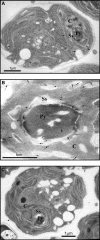Identification of a new chloroplast carbonic anhydrase in Chlamydomonas reinhardtii
- PMID: 15122009
- PMCID: PMC429345
- DOI: 10.1104/pp.103.037283
Identification of a new chloroplast carbonic anhydrase in Chlamydomonas reinhardtii
Abstract
Carbonic anhydrases (CA) are zinc-containing metalloenzymes that catalyze the reversible hydration of CO2. The three evolutionarily unrelated families of CAs are designated alpha-, beta-, and gamma-CA. Aquatic photosynthetic organisms have evolved different forms of CO2 concentrating mechanisms (CCMs) to aid Rubisco in capturing CO2 from the surrounding environment. One aspect of all CCMs is the critical roles played by various specially localized extracellular and intracellular CAs. Five CAs have previously been identified in Chlamydomonas reinhardtii, a green alga with a well-studied CCM. Here we identify a sixth gene encoding a beta-type CA. This new beta-CA, designated Cah6, is distinct from the two mitochondrial beta-CAs in C. reinhardtii. Nucleotide sequence data show that the Cah6 cDNA contains an open reading frame encoding a polypeptide of 264 amino acids with a leader sequence likely targeting the protein to the chloroplast stroma. We have fused the Cah6 open reading frame to the coding sequence of maltose-binding protein in a pMal expression vector. The purified recombinant fusion protein is active and was used to partially characterize the Cah6 protein. The purified recombinant fusion protein was cleaved with protease Factor Xa to separate Cah6 from the maltose-binding protein and the purified Cah6 protein was used to raise an antibody. Western blots, immunolocalization studies, and northern blots collectively indicated that Cah6 is constitutively expressed in the stroma of chloroplasts. A possible role for Cah6 in the CCM of C. reinhardtii is proposed.
Figures










References
-
- Amoroso G, Weber C, Sültemeyer DF, Fock HP (1996) Intracellular carbonic anhydrase activities in Dunaliella tertiolecta (Butcher) and Chlamydomonas reinhardtii (Dangeard) in relation to inorganic carbon concentration during growth: further evidence for the existence of two distinct carbonic anhydrases associated with the chloroplast. Planta 199: 177–184
-
- Badger MR, Price GD (1992) The CO2 concentrating mechanism in cyanobacteria and microalgae. Physiol Plant 84: 606–615
Publication types
MeSH terms
Substances
Associated data
- Actions
- Actions
LinkOut - more resources
Full Text Sources

